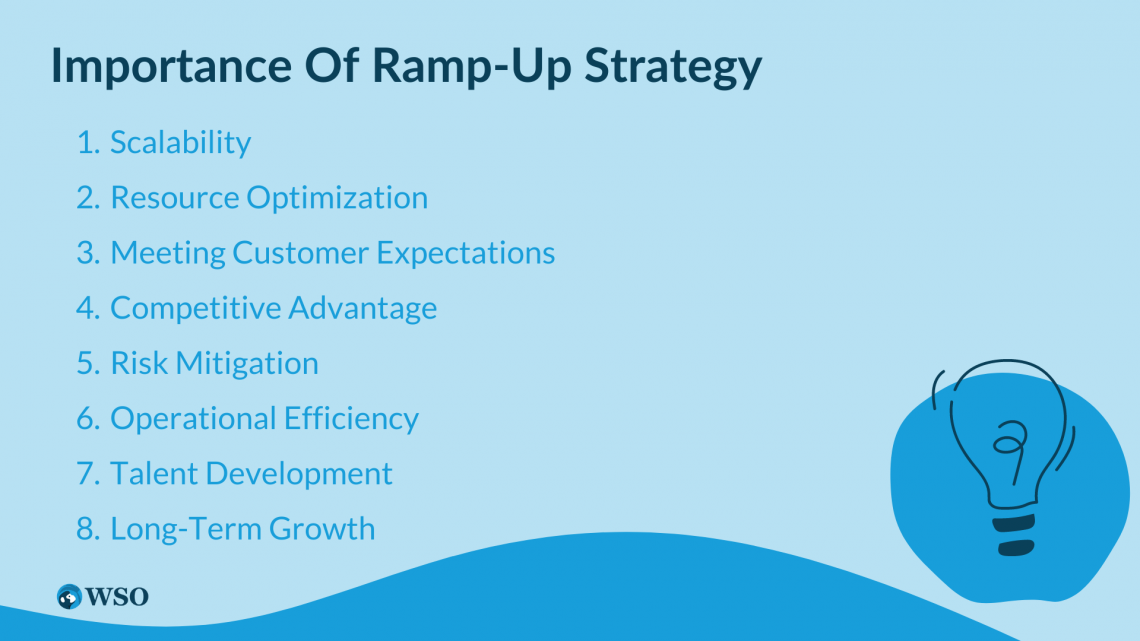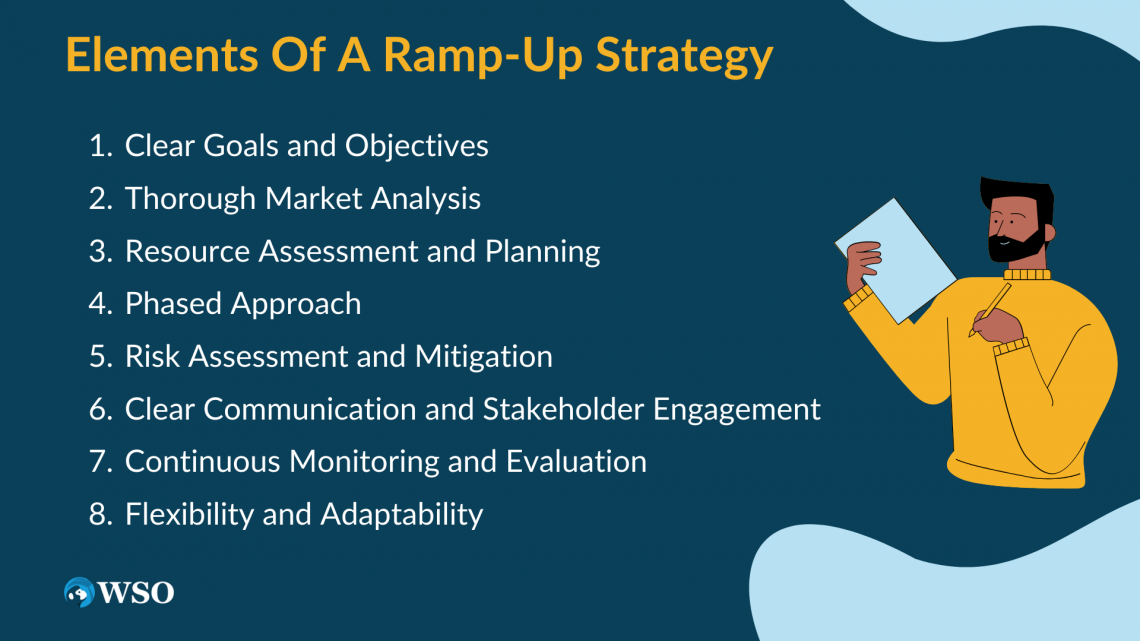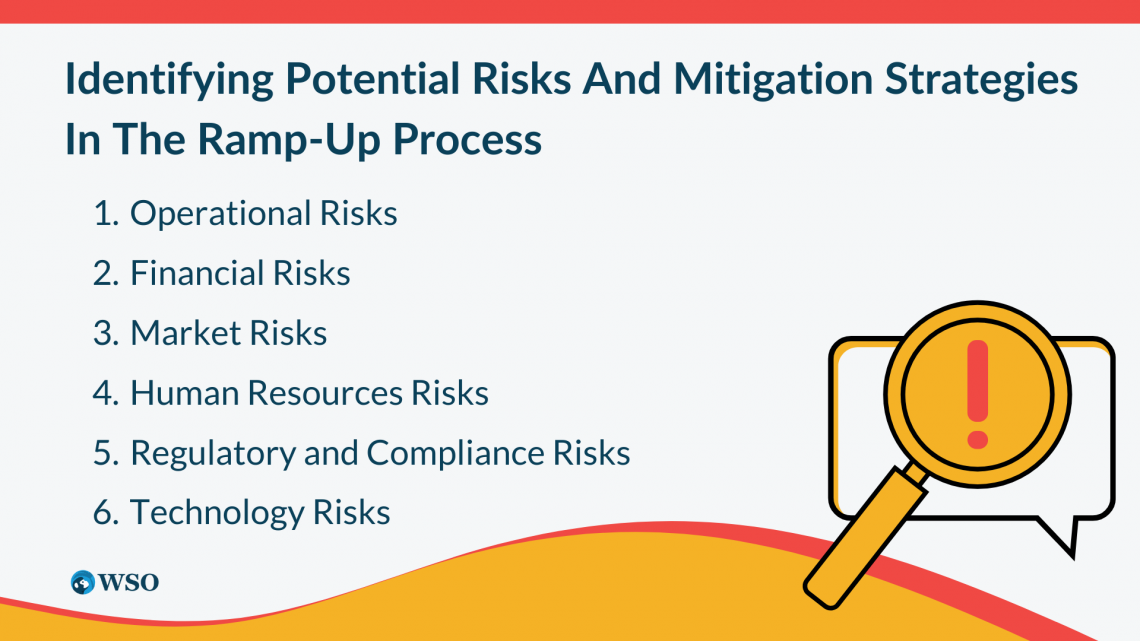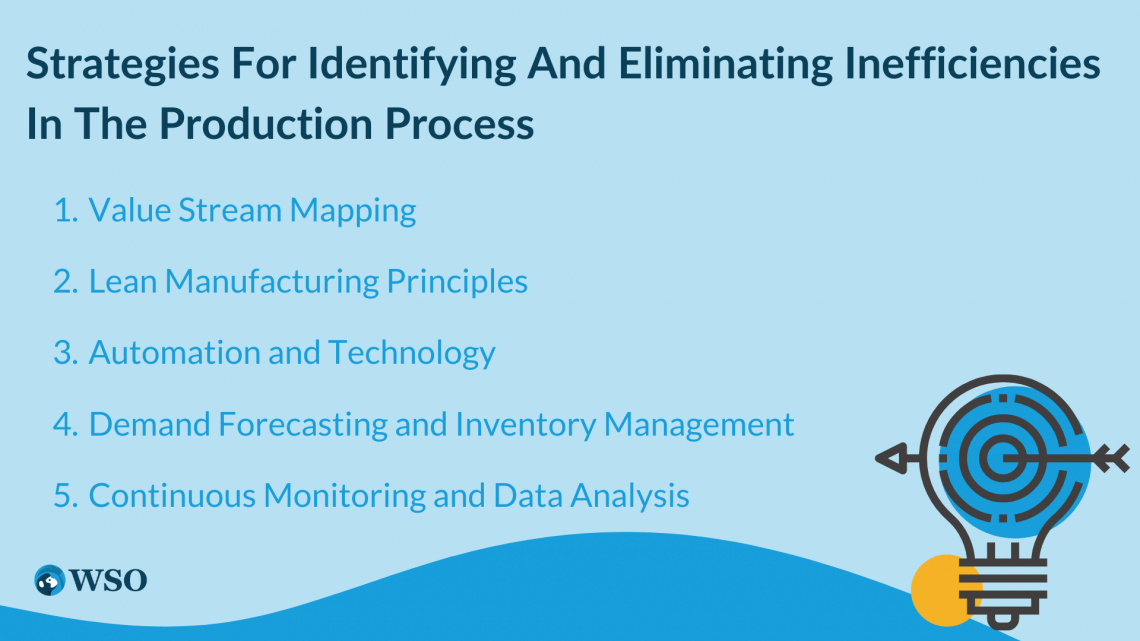Ramp-Up
It refers to scaling up operations in a phased and planned manner
In today's rapidly changing business landscape, organizations usually face the problem of scaling up their operations and achieving growth while maintaining efficiency. Ramp-Up strategy refers to scaling up operations in a phased and planned manner.

This is where a well-designed ramp-up strategy comes into the picture. It is a systematic approach businesses adopt to increase their production capacity, expand their market presence, and optimize their resources effectively.
It involves a planned and phased implementation process that enables organizations to smoothly transition from their current state to a higher level of performance.
The primary objective of it is to maximize efficiency and growth. By carefully analyzing the market demand, competitive landscape, and internal capabilities, businesses can identify expansion opportunities and develop a roadmap to capitalize on them.
A well-executed this strategy offers several benefits. Firstly, it allows businesses to meet growing customer demands by efficiently increasing their production capacity.
This enables them to seize new market opportunities and gain a competitive edge. Secondly, it optimizes resource allocation by identifying and eliminating inefficiencies in the production process.

By streamlining operations, businesses can reduce costs, improve productivity, and enhance overall profitability.
Moreover, it helps organizations manage risks effectively. It involves conducting thorough risk assessments and developing mitigation plans to minimize potential disruptions during the scaling-up process.
By proactively addressing potential challenges, businesses can maintain a smooth transition and prevent costly delays.
Additionally, it promotes innovation and adaptability. As organizations scale up, they can leverage new technologies, implement process improvements, and explore innovative solutions to meet increased demand efficiently.

This fosters a culture of continuous improvement and drives sustainable growth. It is essential for organizations looking to maximize efficiency and achieve sustainable growth.
By carefully planning and executing a phased approach, businesses can overcome operational challenges, optimize resource utilization, and capitalize on market opportunities.
Embracing a ramp up strategy enables organizations to build a strong foundation for expansion and adapt to the ever-evolving business landscape.
Key Takeaways
- A ramp-up strategy is necessary for organizations aiming to achieve growth and maximize efficiency by efficiently scaling up operations and meeting customer demands.
- Clear goals and objectives, thorough market analysis, resource assessment and planning, a phased approach, risk assessment, and mitigation, flexibility, and adaptability are key elements of a successful ramp-up strategy.
- Organizations should conduct a complete risk assessment to identify operational, financial, market, human resources, regulatory and compliance, and technology risks.
- Common mistakes in the ramp-up process include insufficient planning, underestimating resource needs, lack of risk assessment, poor communication, and stakeholder management, and overlooking continuous monitoring and evaluation.
- To avoid these pitfalls, organizations should invest time and effort in detailed planning, accurately assess and allocate resources, maintain open communication with stakeholders, and continuously monitor and evaluate the ramp-up process.
Importance of Ramp-Up Strategy
It is a vital component for businesses aiming to achieve growth and maximize efficiency. Here are some key points highlighting the importance of a ramp-up strategy:

1. Scalability
It enables businesses to scale their operations efficiently. It provides a structured approach to increasing production capacity, expanding market reach, and meeting growing customer demands.
Without a well-defined strategy, organizations may struggle to handle increased workloads and face operational bottlenecks.
2. Resource Optimization
By implementing a ramp-up strategy, businesses can optimize their resources effectively. This includes assessing current resources, identifying gaps, and allocating them appropriately to support the scaling process.
This optimization helps reduce wastage, improve productivity, and enhance overall operational efficiency.
3. Meeting Customer Expectations
As a business grows, so do customer expectations. It ensures that organizations meet increasing demands and deliver products or services on time.
NOTE
Businesses can enhance customer satisfaction and loyalty by aligning production capabilities with customer needs.
A well-executed ramp-up strategy provides a competitive edge in the market. It enables businesses to respond quickly to market trends, capitalize on emerging opportunities, and outperform competitors.
This agility allows organizations to establish a strong market presence and stay ahead of the competition.
5. Risk Mitigation
Scaling up operations involves inherent risks. It helps identify potential risks and develop mitigation plans to minimize disruptions.
NOTE
By proactively addressing risks, organizations can reduce the likelihood of costly setbacks and maintain a smooth transition during the scaling process.
6. Operational Efficiency
A ramp-up strategy focuses on streamlining operations and improving efficiency. Businesses can identify inefficiencies, implement process improvements, and optimize workflows by analyzing existing processes.
This leads to cost savings, enhanced productivity, and increased profitability.
7. Talent Development
Scaling up often requires additional workforce capacity. It involves assessing staffing needs, providing training and development programs, and hiring new talent when necessary.
NOTE
The investment in human resources ensures that the organization has the right skills and expertise to support growth.
8. Long-Term Growth
A ramp up strategy lays the foundation for sustainable long-term growth. It enables businesses to expand their market presence, increase revenues, and create opportunities for future expansion.
Organizations can achieve their growth objectives by planning and executing this strategy while maintaining stability.
Elements of a Ramp-Up Strategy
A successful strategy requires careful planning, execution, and monitoring. Here are some key elements that contribute to the effectiveness of a ramp-up strategy:

1. Clear Goals and Objectives
A successful ramp-up strategy starts with clearly defined goals and objectives. These goals should be specific, measurable, attainable, relevant, and time-bound (SMART).
Setting clear goals helps align the entire organization's efforts toward a common vision and provides a roadmap for the ramp-up process.
2. Thorough Market Analysis
Before scaling up operations, it is crucial to conduct a comprehensive market analysis. This includes assessing market demand, identifying potential customers, understanding competition, and analyzing industry trends.
NOTE
A deep understanding of the market landscape enables businesses to make informed decisions and target their ramp-up efforts effectively.
3. Resource Assessment and Planning
Assessing available resources and planning for their optimal utilization is a critical element of a successful strategy.
This includes evaluating production capacity, technology infrastructure, human resources, and financial capabilities. Adequate resource planning ensures that the necessary resources are in place to support the process.
4. Phased Approach
Implementing a phased approach is key to a successful ramp-up strategy. Breaking down the process into manageable phases allows for better control and reduces the risk of overwhelming the organization.
NOTE
Each phase should have defined milestones, timelines, and performance indicators to track progress effectively.
5. Risk Assessment and Mitigation
Identifying and managing risks is essential for a smooth process. Businesses should conduct a thorough risk assessment to identify potential challenges and develop mitigation strategies.
This involves analyzing operational, financial, and market risks and implementing measures to minimize their impact.
6. Clear Communication and Stakeholder Engagement
Effective communication is crucial throughout the process. It is important to keep all stakeholders, including employees, customers, suppliers, and investors, well-informed about the progress, changes, and expectations during the ramp-up phase.
NOTE
Involving and engaging stakeholders during a transition helps build support and address concerns, ensuring a smoother process.
By keeping stakeholders informed about progress, changes, and expectations, businesses foster a sense of inclusion and transparency.
This builds trust, mitigates resistance, and encourages stakeholders to actively participate, ultimately increasing the likelihood of a successful and well-supported transition.
Engaging stakeholders and addressing their concerns foster support and buy-in, ensuring a smoother transition.
7. Continuous Monitoring and Evaluation
Regular monitoring and evaluation are essential to assess the effectiveness of the strategy. Key performance indicators (KPIs) should be established to measure progress, identify areas for improvement, and make necessary adjustments.
NOTE
Monitoring allows businesses to stay on track and make informed decisions throughout the ramp-up process.
8. Flexibility and Adaptability
Flexibility and adaptability are crucial elements of a successful strategy. As the business environment evolves, it is important to be open to adjustments and changes in the ramp-up plan.
This flexibility allows businesses to respond to unforeseen challenges and take advantage of emerging opportunities.
Identifying Potential Risks and Mitigation Strategies in the Ramp-Up Process
The ramp-up process, which is essential for business growth, comes with its threats and risks.

Identifying potential risks and developing effective mitigation strategies is crucial for a successful process. Here are key considerations for identifying risks and implementing mitigation strategies:
1. Operational Risks
These risks encompass factors that could disrupt the smooth functioning of the process. These may include inadequate infrastructure, equipment failures, supply chain disruptions, or insufficient staffing.
NOTE
Mitigation strategies for operational risks involve conducting a thorough assessment of operational capabilities, ensuring redundancy and backup systems, establishing robust supplier relationships, and implementing contingency plans.
2. Financial Risks
The ramp-up activities often require a significant financial investment. Financial risks include excess costs, cash flow difficulties, and the inability to secure adequate funding.
Mitigation strategies for financial risks involve developing detailed financial projections, securing sufficient funding sources, closely monitoring expenses, and implementing cost control measures.
NOTE
Businesses should also have contingency plans in place to address unexpected financial challenges.
3. Market Risks
These pertain to factors impacting the demand for ramped-up products or services. These risks include changes in market conditions, customer preferences, or competition.
Mitigation strategies for market risks involve conducting thorough market research, diversifying the customer base, maintaining strong customer relationships, and continuously monitoring market trends.
Businesses should also have agility in adapting to changing market dynamics and diversifying their product or service offerings.
4. Human Resources Risks
It involves challenges related to workforce management and talent acquisition during the process.
NOTE
Risks may include a shortage of skilled employees, difficulty in attracting and retaining talent, or inadequate training and development programs.
To effectively manage human resources risks during the ramp-up process, businesses can take several steps.
First, conducting a comprehensive talent assessment helps identify staffing needs and skill gaps.
This information can guide the development of effective recruitment and retention strategies, such as offering competitive compensation packages and creating an attractive work environment.
Additionally, investing in training and development programs enhances employees' skills and capabilities, ensuring they are equipped to handle increased responsibilities.
Lastly, fostering a positive organizational culture that values and supports employees contributes to their satisfaction and reduces the risk of turnover.
Mitigation strategies for human resources risks include conducting a comprehensive talent assessment, implementing effective recruitment and retention strategies, investing in employee training and development, and fostering a positive organizational culture.
5. Regulatory and Compliance Risks
These risks arise from non-compliance with laws, regulations, or industry standards. These risks could lead to legal issues, reputational damage, or fines.
NOTE
Mitigation strategies involve staying updated with relevant regulations, conducting regular compliance audits, establishing robust internal control systems, and ensuring employee awareness and adherence to regulatory requirements.
6. Technology Risks
It involves challenges related to implementing and integrating new technologies during the ramp-up process. Risks may include system failures, data breaches, or inadequate technology infrastructure.
Mitigation strategies for technology risks include conducting thorough technology assessments, ensuring robust cybersecurity measures, implementing effective backup and recovery systems, and providing comprehensive training and support for employees.
Ramp-Up Process Common Mistakes
The process is a critical phase for businesses as they scale up their operations to meet increased demand or expand into new markets.

However, there are common mistakes that companies should avoid to ensure a successful transition. Let's explore some of these pitfalls with real-world examples.
1. Inadequate Planning and Preparation
One of the biggest mistakes is rushing into the process without thorough planning and preparation. This can lead to inefficiencies, delays, and costly mistakes. Tesla, which faced challenges in the production ramp-up of its Model 3 electric vehicle.
Insufficient planning resulted in production bottlenecks, quality issues, and missed delivery targets. To avoid this pitfall, companies should conduct comprehensive market analysis, assess resource needs, and develop a detailed plan with clear goals and milestones.
2. Lack of Scalable Infrastructure
Insufficient infrastructure to support increased production is a common pitfall. An example of this is Amazon's Prime Day event in 2018. The surge in online orders overwhelmed Amazon's servers, leading to website crashes and delayed shipments.
NOTE
To avoid this pitfall, businesses should invest in scalable technology infrastructure, robust supply chains, and adequate logistics capacity to handle increased demand.
3. Ineffective Communication and Stakeholder Engagement
Poor communication and lack of stakeholder engagement can hinder the ramp-up process. Nokia's transition from traditional cell phones to smartphones serves as an example.
The company failed to effectively communicate its strategic shift to employees and external stakeholders. As a result, Nokia lost market share to competitors like Apple and Samsung.
NOTE
To avoid this pitfall, companies should maintain transparent and open communication channels, engage stakeholders, and provide clear updates on progress and expectations.
4. Insufficient Talent Development
Neglecting talent development can hinder the ramp-up process. BlackBerry, once a dominant player in the smartphone market, faced challenges when it failed to adapt to the rise of touchscreen smartphones.
This was partly due to a lack of skilled talent with expertise in touchscreen technology. To avoid this, businesses should assess staffing needs, implement training and development programs, and create a supportive environment for employees to enhance their skills and capabilities.
5. Ignoring Continuous Monitoring and Evaluation
Failing to monitor and evaluate the process can result in missed opportunities for improvement. Target Corporation faced challenges during its expansion into Canada, mainly due to inadequate monitoring of operations.
The company experienced inventory management issues, supply chain disruptions, and poor customer experience. To avoid this, companies should establish key performance indicators (KPIs), regularly monitor progress, identify bottlenecks, and make necessary adjustments.
NOTE
By learning from the mistakes of real-world companies like Tesla, Amazon, Nokia, BlackBerry, and Target, businesses can enhance their planning, infrastructure, communication, talent development, and monitoring strategies to ensure a smoother and more successful transition.
Strategies For Identifying And Eliminating Inefficiencies In The Production Process
Resource optimization plays an imperative role in maximizing productivity, reducing costs, and improving overall efficiency in the production process.

By identifying and eliminating inefficiencies, businesses can correct their operations and make the most effective use of their resources.
Let's explore some specific strategies and techniques that can be employed for resource optimization, along with relevant examples and case studies.
1. Value Stream Mapping
Value stream mapping is a technique that visually maps out the flow of materials, information, and processes involved in the production process. It helps identify areas of waste, bottlenecks, and unnecessary steps.
By analyzing the value stream map, businesses can pinpoint inefficiencies and implement targeted improvements.
NOTE
Toyota, for instance, utilized value stream mapping to optimize its production processes and reduce lead times, resulting in significant cost savings and improved customer satisfaction.
2. Lean Manufacturing Principles
Lean manufacturing focuses on minimizing waste and maximizing value.
It involves techniques such as just-in-time (JIT) production, 5S methodology, and continuous improvement. Nike, a global leader in athletic footwear and apparel, implemented lean manufacturing principles to optimize its supply chain and reduce inventory costs.
By streamlining production and eliminating waste, Nike was able to achieve faster delivery times and increase its competitive advantage.
3. Automation and Technology
Automation and technology play a vital role in optimizing resources by increasing efficiency and reducing human error.
Robotics and artificial intelligence (AI) can automate repetitive tasks, improve accuracy, and enhance productivity.
Example
Amazon's fulfillment centers provide a notable example of resource optimization through automation. The company utilizes robots to automate warehouse operations, improving order processing speed and minimizing labor costs.
4. Demand Forecasting and Inventory Management
Accurate demand forecasting and efficient inventory management are essential for resource optimization.
By analyzing historical data, market trends, and customer behavior, businesses can forecast demand more accurately, enabling them to optimize production and inventory levels.
Walmart, known for its efficient supply chain management, uses advanced analytics and forecasting techniques to optimize its inventory levels, reducing costs and minimizing stockouts.
5. Continuous Monitoring and Data Analysis
Continuous monitoring and data analysis allow businesses to identify inefficiencies and make data-driven decisions for resource optimization. Key performance indicators (KPIs) and real-time data monitoring help track performance and identify areas for improvement.
Tesla uses data analytics to monitor its production processes and identify bottlenecks, enabling them to make adjustments and optimize resource allocation.
Resource optimization is crucial for enhancing efficiency and reducing costs in the production process.
NOTE
Strategies such as value stream mapping, lean manufacturing principles, automation and technology, demand forecasting, and continuous monitoring and data analysis can help identify and eliminate inefficiencies.
Real-world examples from companies like Toyota, Nike, Amazon, Walmart, and Tesla demonstrate the practical application of these strategies and techniques.
By implementing these approaches, businesses can optimize their resources, streamline operations, and achieve sustainable competitive advantages.




or Want to Sign up with your social account?